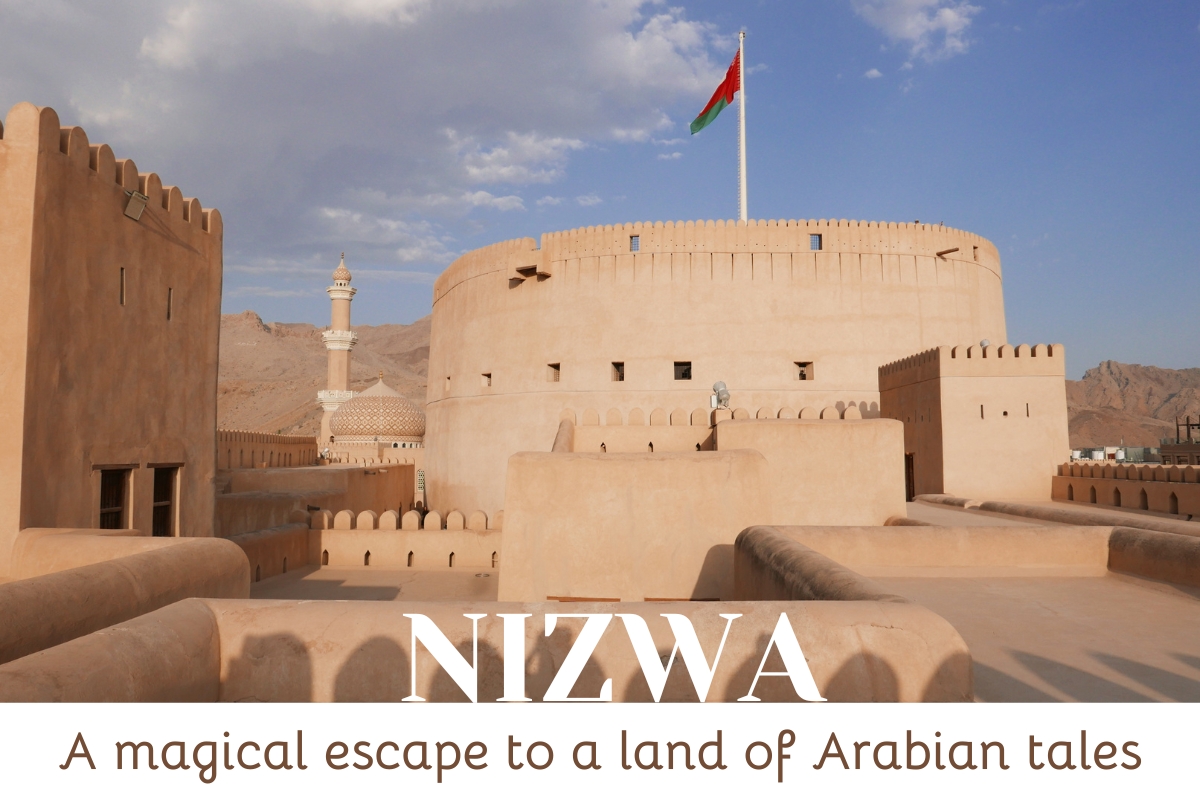
Dear friend,
How are you these days?
Nizwa, a two-hour drive from Muscat, is a journey into a land of ancient tales. The road twists and turns among majestic limestone cliffs, as if I were wandering through a different realm. The mud-brick houses and watchtowers emerge from the rugged landscape, standing steadfast against the elements, silent yet majestic.
I wonder where this sunny day is taking me.
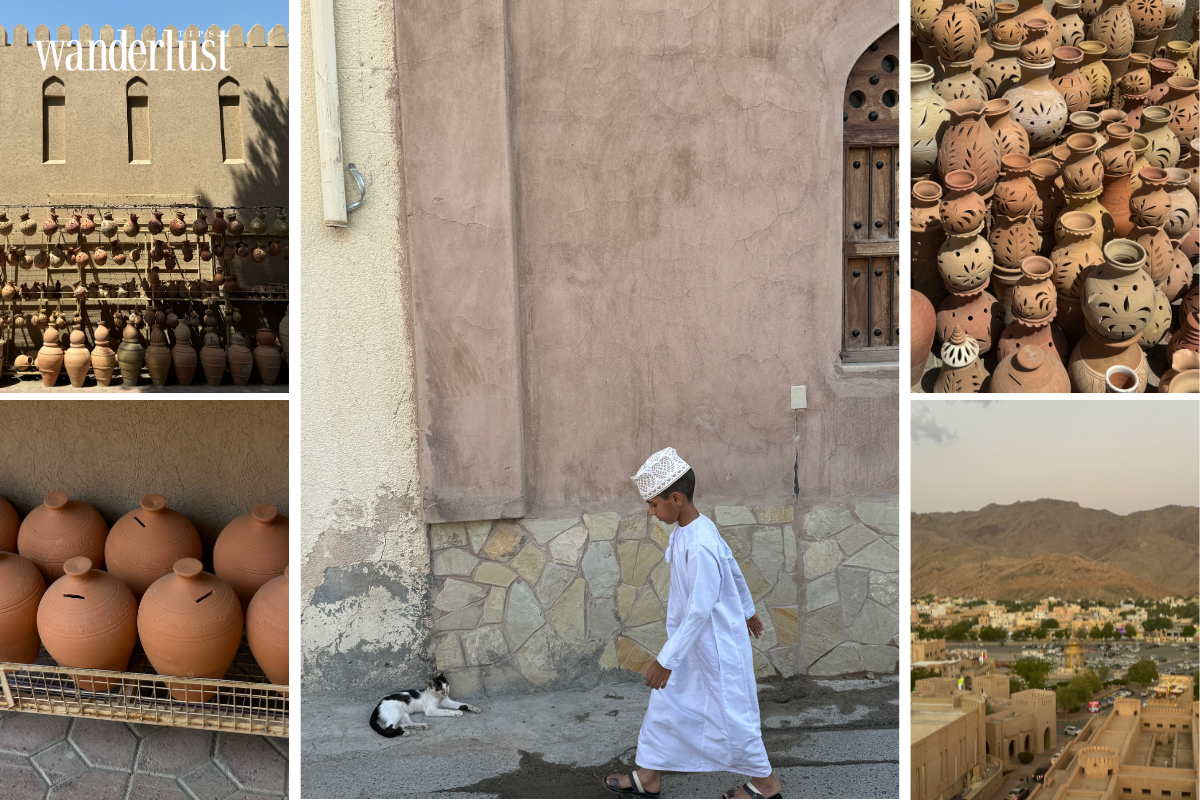
Remember the first day I set foot in Nizwa, I felt like I had wandered into a thousand and one nights fairytale. Here, five times a day, the call to prayer (adhan) echoes from the mosques, resonating through the still air. People stop what they are doing, face Mecca, and perform salat, one of the five pillars of Islam. Men wear Dishdasha, simple white long robes, and wear Kumma or Massar, each different in color and pattern, as if each person weaves their own story through every stitch.
Women here choose a much more modest approach. They wear Abaya – a long black robe that covers the entire body, and most wear Niqab or Burqa to cover their faces, revealing only their eyes. This tradition is not only a symbol of modesty but also adherence to the strict rules of Islam regarding humility and respect. According to Islamic law, distance between men and women is necessary to maintain purity and morality in society. Men and women are not allowed to be in close contact when they are not immediate family, and this separation is evident in daily activities, especially in public places like the market. Most of the people I met at the market were men, busy buying and selling, while women mostly kept their distance, respecting the separation according to the teachings.
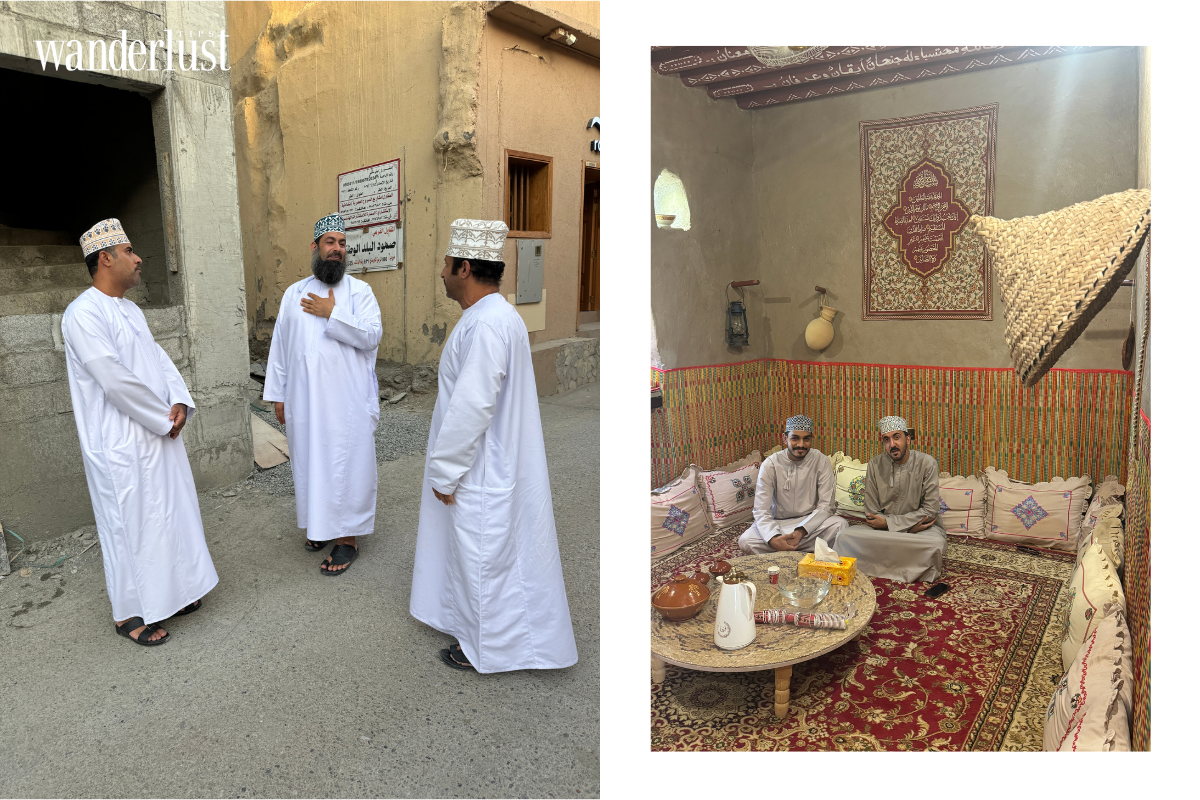
Life here is slow and peaceful, as if guided by the call to prayer every day. From 12 noon to 4 pm, the city falls into a short nap, when the heat like a furnace forces everyone to stop, close the doors to rest or go to the mosque to pray. This is the moment when Nizwa is silent, only the sound of wind and sun through the narrow streets remains.
And so am I. If I don’t take a nap, I’ll sit and read a book on the porch of the western market, refreshing myself with pomegranate juice, which is in season.
Nizwa Fort, built in the 17th century, stands proudly in the heart of the city like a witness to time. It is strong, solid, but also like a mysterious labyrinth. From above, looking at the continuous terraces, it feels like they are always in sight, but when I try to walk through, I get lost, not knowing which stairs to follow. Like playing hide-and-seek in a dream – the turns and corridors intertwine, as if the fort is hiding itself. There is something romantic about the way the fort protects itself, both strong and easy to get lost in. It’s like love – no matter how strong, sometimes people can easily get lost when they immerse themselves in it.
It’s strange that I find romance in a military building.
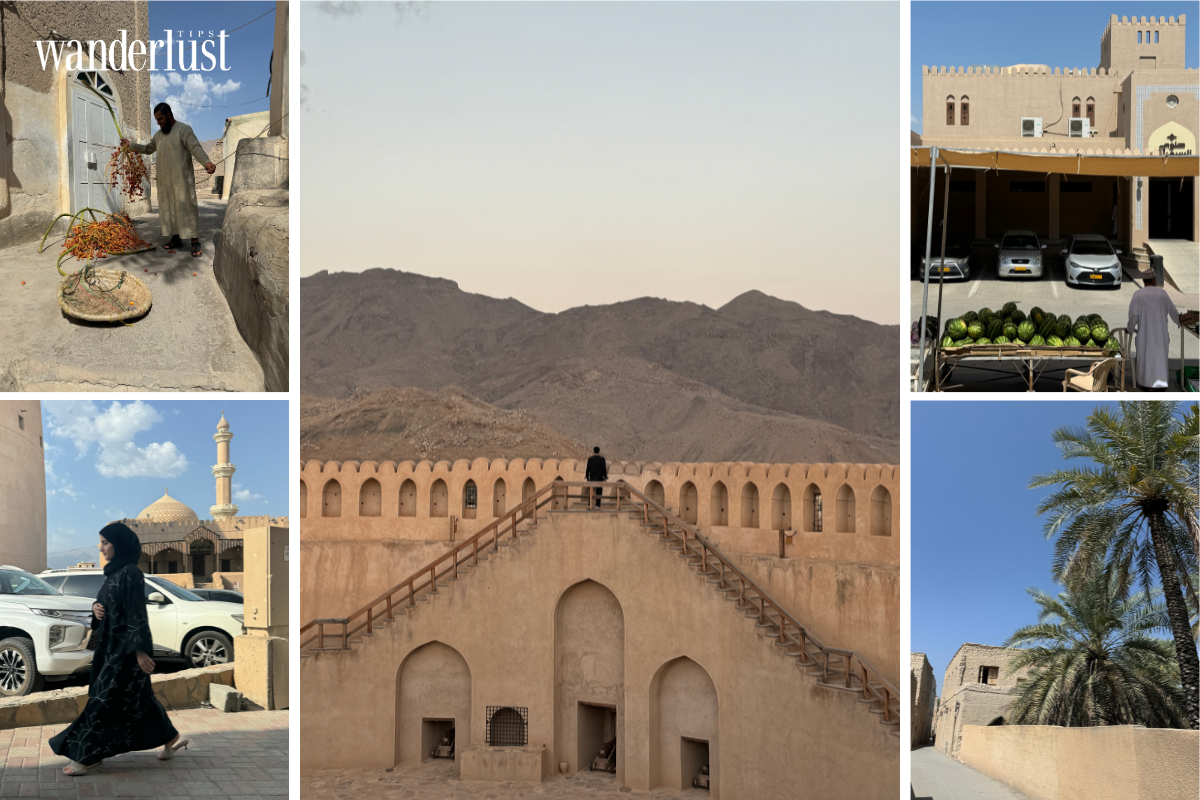
From the top of the fort, the city appears with its brown-yellow mud houses, sprawling palm gardens, and the call to prayer echoing from the speakers, casting a sacred veil over the scene. I suddenly thought of Rumi’s words: “Prayer is not a ritual, it is a dialogue with God. There, your soul finds peace.” Everything seemed to pause in that moment.
The people here have deep eyes hidden behind long lashes, concealing untold stories, as if they have lived through generations, bound to the rhythm of prayer and ancient scriptures. I met a boy who took me through small paths, across a palm field that was ripening, gradually changing color from green to honey yellow. We crossed the dry river, where only small pebbles glistened in the sun. The boy said the dates were still sour this season, if you eat them, you have to drink them with Omani coffee, strong but gentle, but the aftertaste lingers in the memory, just like this city.
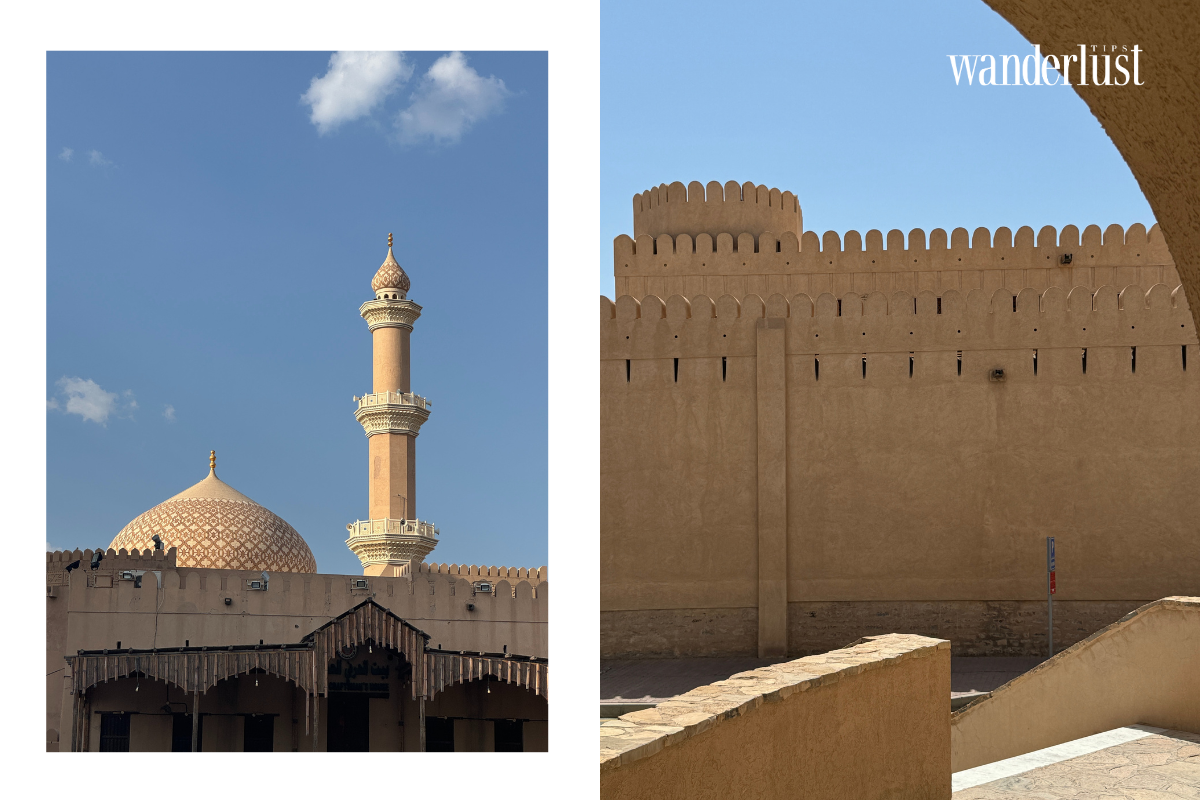
As the sun set, the sky turned red and orange. This morning, I heard the news about the war in Beirut, and although it was only a few hours flight away, Nizwa remained silent as if time had stopped. The Middle Eastern sun, when it sets, is always big and bright, hanging over the distant mountains like a reminder of eternity. My companion said to me, “Brother, Just watch the sunset, I have to go to pray. See you later.”
I stood still, watching the sun slowly set behind the mountains, thinking about the peace here and the turmoil elsewhere. Life is too short, everyone clings to their own beliefs. When it was completely dark, I naturally felt the need to pray, unconsciously, like a newly formed habit.
My friend, I will go to pray as well.
I hope you are well.
Nizwa
QD | 09.2024
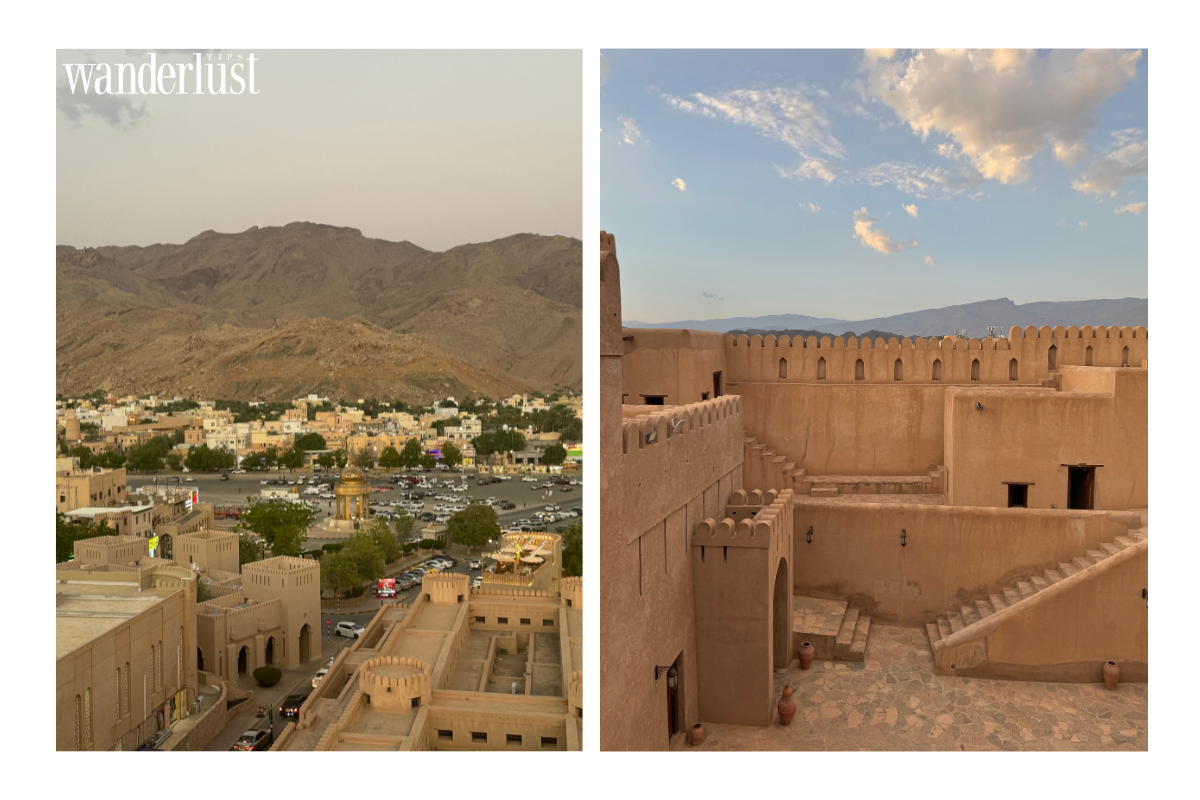 WANDERLUST TIPS
WANDERLUST TIPS
Located about a two-hour drive from Muscat, the capital of Oman, Nizwa stands as one of the oldest and most charming cities in the country. With its massive fort, bustling traditional market, and ancient villages, Nizwa is like a living museum, preserving the long-standing Islamic cultural values.
Weather
Nizwa experiences a desert climate, characterized by hot and dry conditions. For the most comfortable trip, it’s essential to understand the local weather and choose the best time to visit.
The ideal time to visit Nizwa is during the autumn (September-November) and winter (December-February) months. During these periods, the weather is cool and pleasant, making it perfect for outdoor activities and exploring the city. Spring (March-May) sees a gradual increase in temperature, but it remains relatively comfortable. It’s also the blooming season, making the landscape more beautiful.
Transportation
From the USA, passengers can choose flights operated by Qatar Airways, Emirates Airlines, Oman Air to Muscat International Airport, Oman, with a transit stop in Doha (Qatar) or Dubai (UAE). Upon arrival at Muscat, travelers can rent a car, hire a taxi (priced between 50-70 OMR), or utilize public bus services (2.1 OMR per person) to travel to Nizwa city.
For travelers opting to stay in the Nizwa Souq area, renting a 50cc motorbike or walking are suitable options to explore the small streets in this vicinity.
Cuisine
Omani cuisine offers a captivating fusion of Asian and European culinary influences, resulting in a unique and flavorful gastronomic experience. Some must-try traditional Omani dishes include:
- Kabsa: A fragrant saffron-infused rice dish, enriched with tender chicken or lamb, an array of vegetables, and aromatic spices, is a staple on special occasions.
- Shuwa: A culinary masterpiece, Shuwa features succulent lamb or goat marinated to perfection, wrapped in banana leaves, and slow-cooked underground, yielding a tender and aromatic meat.
- Mashuai: Indulge in the rich and savory flavors of Mashuai, a whole grilled fish, typically sea bass, marinated with a blend of spices and lemon sauce.
- Majboos: A variant of Kabsa, Majboos features tender beef and a delightful medley of nuts, creating a more complex flavor profile.
- Meshkak: Savor the succulent flavors of Meshkak, tender pieces of beef or lamb marinated in aromatic spices and grilled to perfection over charcoal.
- Halwa: Delight your sweet tooth with Halwa, a traditional confection made from sugar, walnuts, and a variety of nuts. This versatile dessert is often enjoyed with a cup of coffee.
- Laban: Quench your thirst with Laban, a refreshing Omani yogurt with a tangy flavor, often infused with mint or dill.
- Karak tea: Experience the unique taste of Karak tea, a beloved Omani beverage characterized by its sweet and aromatic flavor, traditionally served in small glass cups.
- Omani coffee: Savor the robust and aromatic flavors of traditional Omani coffee, meticulously roasted and brewed to perfection.

